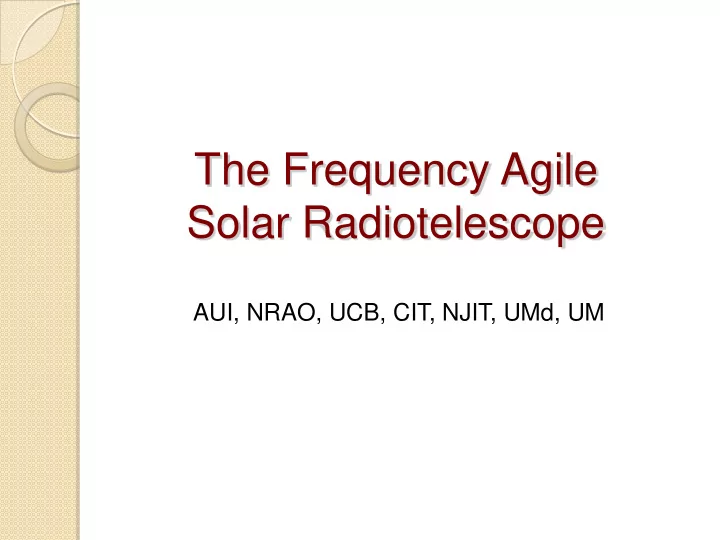

The Frequency Agile Solar Radiotelescope AUI, NRAO, UCB, CIT, NJIT, UMd, UM
The Innovation Ultra-wideband imaging spectroscopy of the solar atmosphere from the chromosphere to the outer corona with temporal, angular, and spectral resolution matched to the physical process that occur. Brightness temperature as a B x , y , , t , T function of position, frequency, time, and polarization The entire solar atmosphere will be imagined in 3D from the mid-chromosphere to the outer-corona once every second!
Frequency 50 MHz - 21 GHz FASR range Data channels, Specifications bandwidth, freq. 2/500 MHz/4000/20 channels, int. ms (descope) time A: ~45 (990 pairs) Number B: ~15 (105 ) FASR A: ~2.5-21 GHz antennas C: ~15 (105) FASR B: ~0.25-3 GHz A: 2 m FASR C: ~50-300 MHz B: 6 m Size antennas C: LPD tiles or similar Polarization Stokes IV(QU) Proposed site is OVRO Angular 20/ 9 arcsec resolution Footprint ~3 km Field of View >0.5 deg
The Science Coronal Magnetic Fields Coronal magnetography Spatiotemporal evolution of fields Role of electric currents in corona Coronal seismology High energy solar physics Magnetic energy release Plasma heating and dynamics Electron acceleration and transport Origin of SEPs Drivers of Space Weather Birth & acceleration of CMEs Prominence eruptions Origin of SEPs Fast solar wind streams
The Science The “thermal” solar atmosphere ◦ Coronal heating - nanoflares ◦ Thermodynamic structure & dynamics ◦ Formation & structure of filaments Solar Wind ◦ Birth in network ◦ Coronal holes ◦ Fast/slow wind streams ◦ Turbulence and waves Synoptic studies ◦ Radiative inputs to upper atmosphere ◦ Global magnetic field/dynamo ◦ Flare statistics
Recent Developments • FASR DDP funded by NSF/ATM in 2006 Development of ultrawideband feeds and integrated amps initiated • FST program funded by NSF/AST ATI in 2006 RFI mitigation • FASR Reference Instrument completed O&M Plan delivered in June 2007 FASR descope/rescope • Preliminary proposal submitted to the NSF/ATM MSI Opportunity program in January 2008 • Full proposal submitted to NSF in June 2008 for $25M Funding decision is imminent!
Definition and Variance of Spectral Kurtosis 4 A k K ( f ) Dwyer (1983) k 2 2 A k N 1 2 2 ikn / N 4 2 X x e X 2 X k n k k SK ( f ) Vrabie (2003) Spectral Kurtosis n 0 k 2 2 X A iB X k k k k 2 2 k Nita (2007) Spectral Variability V k 2 k 2 2 P A B k k k 2 P M k M 1 2 M 1 P P k k k 2 2 2 P P k k k 24 / M , k 0 , N / 2 2 Var V k 4 / M , k 1 ,..., ( N / 2 1 )
Performance and limitations of SK estimator
Software Implementation of RFI excision algorithm
CASPER Hardware Implementation of RFI excision algorithm
Recommend
More recommend